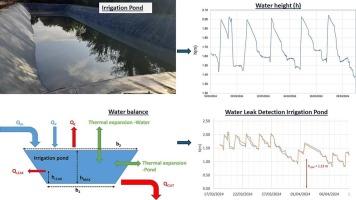A validated low-cost model for precise water leak detection in irrigation ponds (WLDIP)
IF 8.9
1区 农林科学
Q1 AGRICULTURE, MULTIDISCIPLINARY
引用次数: 0
Abstract
Efficient water management in agriculture is crucial for global food security and environmental sustainability, especially in water-scarce regions. Undetected leaks in irrigation ponds lead to significant water losses and increased operational costs. This study aimed to propose a low-cost Water Leak Detection model for Irrigation Ponds (WLDIP), capable of estimating both the location (height) and size of leaks, thereby helping to reduce agricultural water losses. The methodology integrates continuous water level measurements with a detailed water balance model, considering variables such as inflows, outflows, evaporation, and thermal expansion of both the water and the reservoir structure. The model relies on measuring water height every 15 min over a week and uses meteorological data to account for evaporation and thermal expansion. Least squares optimization compares measured data with the model’s calculated values to determine leak parameters. Field validation was conducted on three irrigation ponds in southeastern Spain. The WLDIP model successfully identified leak locations and sizes in all three ponds, which were subsequently confirmed by physical inspections and repairs. Results showed that level variations exceeding 0.01 m within 15 min were due to normal pond use, while leaks exhibited a typical flow rate ten times lower. This demonstrates the model’s high accuracy in determining both the height (hLEAK) and size (ωLEAK) of the leaks. The WLDIP model is a reliable, scalable, and cost-effective solution for improving water use efficiency in agricultural systems. Its implementation aligns with sustainable development goals related to clean water and responsible production, and it helps prevent adverse effects on natural ecosystems, particularly in semi-arid climatic zones. Future research could focus on automating this system for real-time leak monitoring.

一种经验证的低成本灌溉池塘水泄漏精确检测模型
有效的农业用水管理对全球粮食安全和环境可持续性至关重要,特别是在缺水地区。灌溉池中未被发现的泄漏导致大量的水损失,增加了运营成本。本研究旨在提出一种低成本的灌溉池塘漏水检测模型(WLDIP),该模型能够估算泄漏的位置(高度)和大小,从而有助于减少农业用水损失。该方法将连续的水位测量与详细的水平衡模型相结合,考虑了水和水库结构的流入、流出、蒸发和热膨胀等变量。该模型依赖于一周内每15分钟测量一次水位,并使用气象数据来解释蒸发和热膨胀。最小二乘优化将测量数据与模型计算值进行比较,以确定泄漏参数。在西班牙东南部的三个灌溉池塘进行了实地验证。WLDIP模型成功地确定了所有三个池的泄漏位置和大小,随后通过物理检查和维修进行了确认。结果表明,15 min内水位变化超过0.01 m是由于正常使用池塘造成的,而泄漏则表现出10倍的典型流量。这表明该模型在确定泄漏的高度(hLEAK)和尺寸(ωLEAK)方面具有很高的精度。WLDIP模型是提高农业系统用水效率的可靠、可扩展和具有成本效益的解决方案。它的实施符合与清洁水和负责任生产有关的可持续发展目标,并有助于防止对自然生态系统的不利影响,特别是在半干旱气候带。未来的研究可以集中在自动化这个系统的实时泄漏监测上。
本文章由计算机程序翻译,如有差异,请以英文原文为准。
求助全文
约1分钟内获得全文
求助全文
来源期刊

Computers and Electronics in Agriculture
工程技术-计算机:跨学科应用
CiteScore
15.30
自引率
14.50%
发文量
800
审稿时长
62 days
期刊介绍:
Computers and Electronics in Agriculture provides international coverage of advancements in computer hardware, software, electronic instrumentation, and control systems applied to agricultural challenges. Encompassing agronomy, horticulture, forestry, aquaculture, and animal farming, the journal publishes original papers, reviews, and applications notes. It explores the use of computers and electronics in plant or animal agricultural production, covering topics like agricultural soils, water, pests, controlled environments, and waste. The scope extends to on-farm post-harvest operations and relevant technologies, including artificial intelligence, sensors, machine vision, robotics, networking, and simulation modeling. Its companion journal, Smart Agricultural Technology, continues the focus on smart applications in production agriculture.
 求助内容:
求助内容: 应助结果提醒方式:
应助结果提醒方式:


